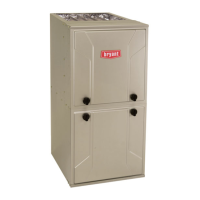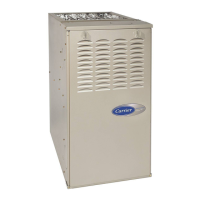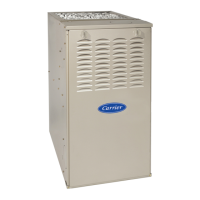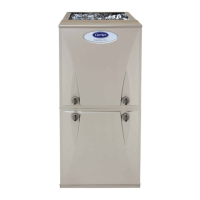915SB: Installation, Start-up, Operating and Service and Maintenance Instructions
Manufacturer reserves the right to change, at any time, specifications and designs without notice and without obligations.
50
c. Run furnace for 3 minutes.
d. Measure time (in sec) for gas meter to complete one revolution
and note reading. The 2 or 5 cubic feet dial provides a more
accurate measurement of gas flow.
e. Refer to Table 18 for cubic ft. of gas per hr.
f. Multiply gas rate cu ft./hr by heating value (BTUh/cu ft.) to
obtain input rate.
g. If clocked rate does not match required input from Step 1,
increase manifold pressure to increase input or decrease manifold
pressure to decrease input. Repeat steps b through e until correct
input is achieved. Re-install regulator seal cap on gas valve.
3. Restore furnace to normal operating condition.
a. Turn gas valve ON/OFF switch to OFF.
b. Remove water column manometer or similar device from
manifold pressure tap.
c. Tighten set screw on manifold tower pressure tap with 3/32-in.
hex wrench, or if 1/8-in. NPT plug was removed, apply pipe
dope sparingly to end of plug and reinstall in the gas valve.
d. Turn gas valve ON/OFF switch to ON.
e. Check for gas leaks and verify furnace operation.
Adjust Temperature Rise
NOTE: Blower door must be installed when taking temperature rise
reading. Leaving blower door off will result in incorrect temperature
measurements, due to possible changes in duct static pressure and
airflow.
This furnace must operate within the temperature rise ranges specified
on the furnace rating plate. Determine the air temperature as follows:
1. Place duct thermometers in return and supply ducts as close to
furnace as possible. Be sure thermometers do not “see” heat
exchangers so that radiant heat does not affect thermometer
readings. This is particularly important with straight run ducts.
2. When thermometer readings stabilize, subtract return-air
temperature from supply-air temperature to determine temperature
rise.
If the temperature rise is outside this range, check the following:
3. Gas input rate.
4. Derate for altitude applicable.
5. Return and supply ducts for excessive restrictions causing static
pressures greater than 0.50-in. w.c. (125 Pa)
6. Adjust temperature rise by adjusting blower speed. Reference
Table 20 - Air Delivery for available heating airflow ranges.
NOTICE
!
For 40,000 BTUH models through 120,000 BTUH models: DO NOT
set manifold pressure less than 2.8-in. w.c. (697 Pa) or more than 3.8 in.
w.c. (947 Pa) for natural gas. If required manifold pressure is outside
this range, change main burner orifices to obtain manifold pressure in
this range.
Table 18 – Gas Rate (CU ft./hr)
SEC
FOR 1
REV
SIZE OF TEST DIAL
SEC
FOR 1
REV
SIZE OF TEST DIAL
1 Cu
Ft.
2 Cu
Ft.
5 Cu
Ft.
1 Cu
Ft.
2 Cu
Ft.
5 Cu
Ft.
10 360 720 1800 55 65 131 327
11 327 655 1636 56 64 129 321
12 300 600 1500 57 63 126 316
13 277 555 1385 58 62 124 310
14 257 514 1286 59 61 122 305
15 240 480 1200 60 60 120 300
16 225 450 1125 62 58 116 290
17 212 424 1059 64 56 112 281
18 200 400 1000 66 54 109 273
19 189 379 947 68 53 106 265
20 180 360 900 70 51 103 257
21 171 343 857 72 50 100 250
22 164 327 818 74 48 97 243
23 157 313 783 76 47 95 237
24 150 300 750 78 46 92 231
25 144 288 720 80 45 90 225
26 138 277 692 82 44 88 220
27 133 267 667 84 43 86 214
28 129 257 643 86 42 84 209
29 124 248 621 88 41 82 205
30 120 240 600 90 40 80 200
31 116 232 581 92 39 78 196
32 113 225 563 94 38 76 192
33 109 218 545 96 38 75 188
34 106 212 529 98 37 74 184
35 103 206 514 100 36 72 180
36 100 200 500 102 35 71 178
37 97 195 486 104 35 69 173
38 95 189 474 106 34 68 170
39 92 185 462 108 33 67 167
40 90 180 450 110 33 65 164
41 88 176 439 112 32 64 161
42 86 172 429 116 31 62 155
43 84 167 419 120 30 60 150
44 82 164 409 124 29 58 145
45 80 160 400 129 28 56 140
46 78 157 391 133 27 54 135
47 76 153 383 138 26 52 130
48 75 150 375 144 25 50 125
49 73 147 367 150 24 48 120
50 72 144 360 157 23 46 115
51 71 141 355 164 22 44 110
52 69 138 346 171 21 42 105
53 68 136 340 180 20 40 100
54 67 133 333
WARNING
!
FIRE HAZARD
Failure to follow this warning could result in personal injury, death,
and/or property damage.
Manifold pressure tap set screw must be tightened and 1/8-in. NPT pipe
plug must be installed to prevent gas leaks.
CAUTION
!
FURNACE DAMAGE HAZARD
Failure to follow this caution may result in:
S Overheating the heat exchangers or condensing flue gases in heat
exchanger areas not designed for condensate.
S Shortened furnace life
S Component damage.
Temperature rise must be within limits specified on furnace rating plate.
Recommended operation is at midpoint of rise range or slightly above.

